Chained to a tree for 40 days: Afghanistan’s shrine to ‘cure’ mental illness
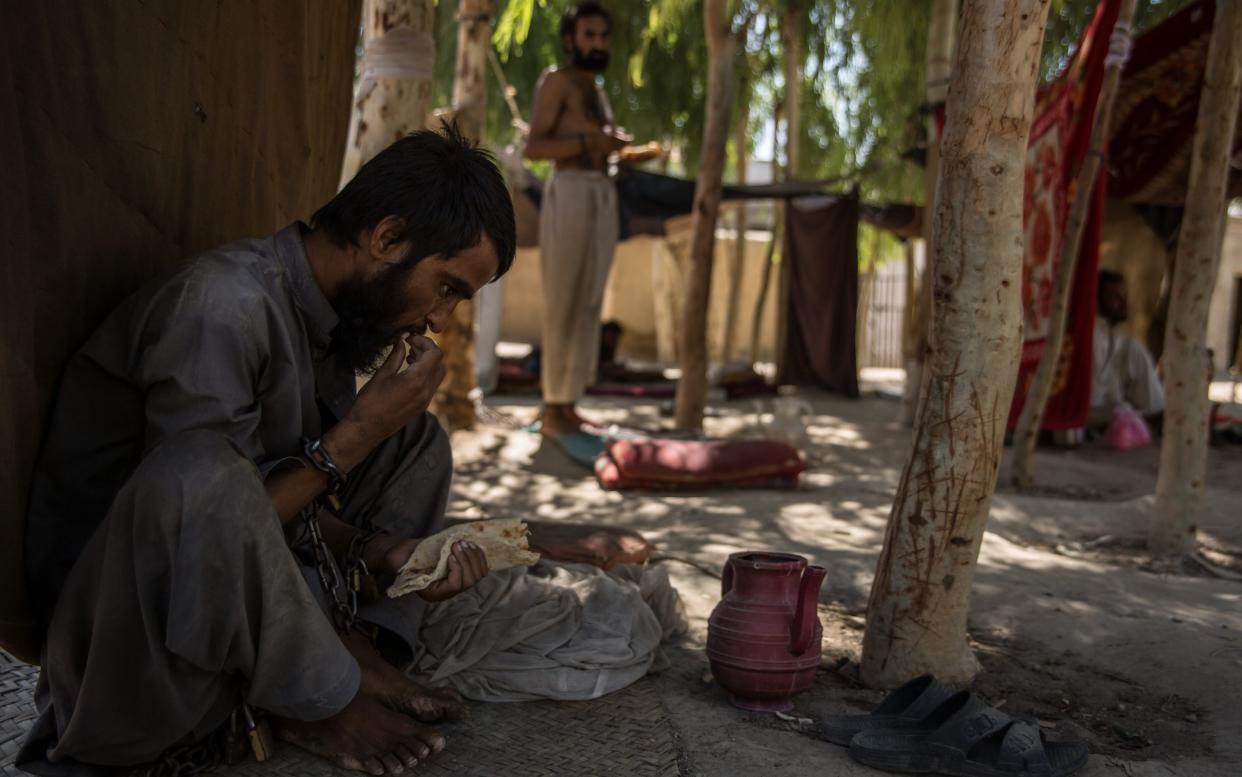
In a dusty graveyard behind nameless tombstones, six men sit with their hands and feet chained to trees, the heavy locks leaving marks and bruises on their skin.
Here, at Mia Ali Sahib shrine in Samarkhel, a village in Afghanistan’s eastern Nangarhar province, Shafirkullah Mia, 45, says he has “cured” more than 600 people over the past decade.
The century-old tradition has families from all over Afghanistan – and even neighbouring Pakistan – bring people struggling with mental illnesses to the shrine, believing that they will be healed after restraining them for 40 days and giving them only dry bread, salt, pepper and water to eat and drink.
Considered a holy site, people pay a daily fee of 250 Pakistani rupees (£1.30) per person – the currency predominantly used in Nangarhar due to its close proximity and strong trade links to Pakistan – to have their ill family members treated, believing that Mia Ali Sahib, a “local saint and good, influential leader” buried in the graveyard, continues to spread his supernatural healing powers.
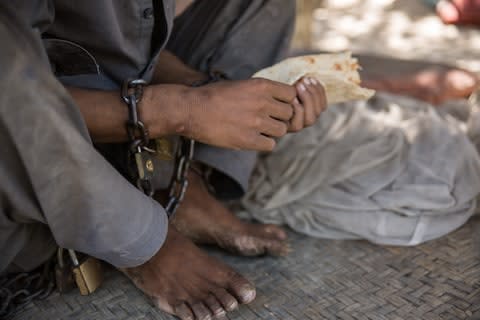
Shafirkullah Mia, who previously worked as a baggage loader at Jalalabad airport, about an hour’s drive west from Samarkhel, says that he has received no formal training to treat his “patients”.
“I’m a descendant of Sahib and our family is famous in all of Afghanistan because we continue to be able to treat severe cases of mental illness,” he explains, while catering to the six men. “Sometimes we have more patients, other times less, but people keep coming, even women. They trust me because of my family lineage – it doesn’t require me to learn about my job because I’m a relative of Sahib’s.”
Faizal Faizal, 25, from neighbouring Kunar province, has been here for the past month. He sits on a straw mat, his hat bowed, his grey shalwar kameez – Afghanistan’s traditional tunic – dirty, and his voice raspy. Heavy locks on both his hands and his feet ensure that he can’t break the thick chains.
“I don’t move all day,” he says, clearing his throat,” and I sleep out here at night.” He sits surrounded by graves with simple stones, a small, green-painted shrine in the midst of the yard was built in memory of Sahib. “Sometimes I’m allowed to go there and pray,” Faizal adds, pointing to the shrine.
The area behind the graves sits in the shade of trees and smells of urine and unwashed clothes. While all of them sleep on the floor outside during the hot summer months, small cave-like rooms, empty and built out of brick, provide shelter during cooler, rainier winters. The chains are never taken off during their 40-day stay.
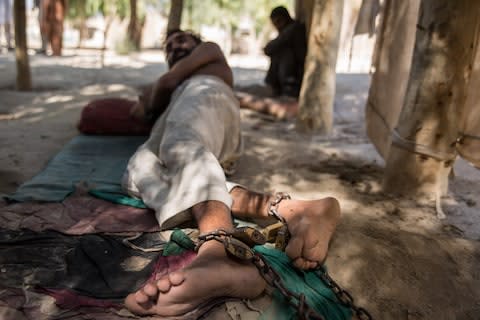
Mia Ali Sahib shrine is in the midst of the approximately 5,000-family village. Many people cross the graveyard on a daily basis, but don’t interact with the people who are put in chains.
Shafirkullah Mia sits with his “patients” all day and even sleeps there at night - some of whom have come from far away provinces. “They are not supposed to talk to each other, so when they do, I yell at them, or I hit them,” he says.
After 40 days, most men leave quietly, broken.
The practise of chaining people in health facilities was only abolished across Afghanistan in 2008, with Mia Ali Sahib shrine being one of the last places to continue with the method. This however still means that hundreds of people are victim to it each year.
“It’s a religious place and people believe that the dead can perform supernatural wonders,” explains psychiatrist Dr. Bashir Ahmad Sarwari, Director of the Department of Mental Health at Afghanistan’s Ministry of Public Health.
“We’ve tried to encourage people to use medical services instead. Ten years ago, we cleared the shrine and offered professional treatment, medicine and proper food to those who were chained there, but shortly after, it started back up again,” he says. “There are many factors that play into it - including low level of education, traditional believes and limited efforts by health providers to offer effective treatment.”
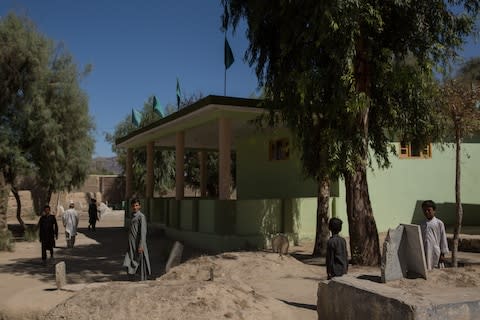
In Samarkhel, locals continue to believe in the shrine’s healing powers, and Mia Ali Sahib’s family continues to run the site as a prosperous business. “God will help them,” Shafirkullah Mia explains. While many women and men arrive at the shrine screaming, their families desperate and no longer able to take care of them anymore, they often leave quieter.
“What is seen as ‘healing’ can be numbness caused by trauma,” explains psychologist Lyla Schwartz, who recently set up a mental health awareness initiative in Afghanistan.
“Medical or physical restraint is sometimes used to protect and ensure clients don’t harm themselves or others, but it should only be temporary and under professional supervision. Physical retrain can exasperate the problem and the lack of integration and social interaction can lead to severe anxiety, panic, depression and aggression. That might be part of the reason why they don’t respond anymore after those 40 days.”
Ashraf Khan, 40, lying on the floor, his head resting on one of his bruised hands, says he’s been at the shrine long enough for his brothers to pick him up again. His eyes stare into the distance as he mumbles words under his breath. Originally from Achin district in Nangarhar, Khan has seen first-hand fighting over the last years. He says he doesn’t know why his brothers brought him to the shrine.
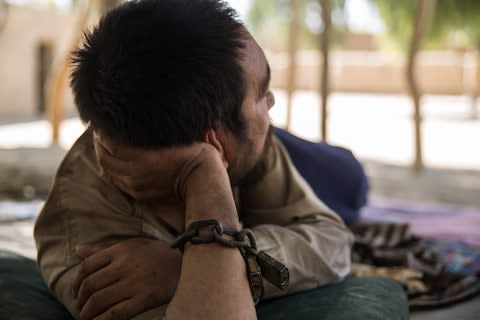
None of the patients have been diagnosed with a mental illness, but many, Shafirkullah Mia says, arrive in a state that their families are unable to cater to. “They might scream or cry or even hurt themselves,” he explains.
According to Fatima Jafari, a psychosocial officer working with Schwartz, people throughout the country continue to lack an understanding of mental health.
“In rural areas, many still believe in ghosts and jinns. Our culture has to adapt in order to prevent practises such as restraining people,” she says.
“It’s dangerous,” Schwartz says. “Going through something so extreme can prevent the hippocampus – the part of the brain which stores memories – from forming new neurones due to high levels of stress, which can cause memory loss and affect the ability to regulate feelings.”
Mia Aziz, 65, father to Shafirkullah Mia argues that. “Sahib was sent by God and thousands of people have been cured,” he explains, adding that “it’s a holy village.” The family has no plans to stop their practise and each week, new people are chained up in the graveyard of Samarkhel village.

Protect yourself and your family by learning more about Global Health Security

 Yahoo News
Yahoo News 